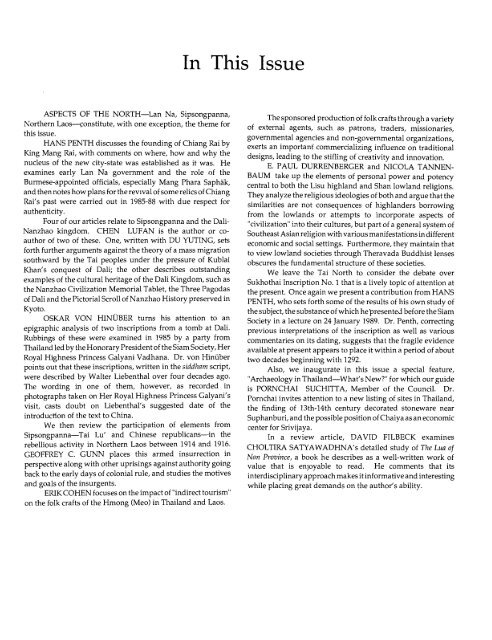The Journal of the Siam Society Vol. LXXVII, Part 1-2, 1989 - Khamkoo
The Journal of the Siam Society Vol. LXXVII, Part 1-2, 1989 - Khamkoo
The Journal of the Siam Society Vol. LXXVII, Part 1-2, 1989 - Khamkoo
You also want an ePaper? Increase the reach of your titles
YUMPU automatically turns print PDFs into web optimized ePapers that Google loves.
In This Issue<br />
ASPECTS OF THE NORTH-Lan Na, Sipsongpanna,<br />
Nor<strong>the</strong>rn Laos-{:onstitute, with one exception, <strong>the</strong> <strong>the</strong>me for<br />
this issue.<br />
HANS PENTH discusses <strong>the</strong> founding <strong>of</strong> Chiang Rai by<br />
King Mang Rai, with comments on where, how and why <strong>the</strong><br />
nucleus <strong>of</strong> <strong>the</strong> new city-state was established as it was. He<br />
examines early Lan Na government and <strong>the</strong> role <strong>of</strong> <strong>the</strong><br />
Burmese-appointed <strong>of</strong>ficials, especially Mang Phara Saphiik,<br />
and <strong>the</strong>n notes how plans fvr <strong>the</strong> revival <strong>of</strong> some relics <strong>of</strong> Chiang<br />
Rai's past were carried out in 1985-88 with due respect for<br />
au<strong>the</strong>nticity.<br />
Four <strong>of</strong> our articles relate to Sipsongpanna and <strong>the</strong> Dali<br />
Nanzhao kingdom. CHEN LUFAN is <strong>the</strong> author or coauthor<br />
<strong>of</strong> two <strong>of</strong> <strong>the</strong>se. One, written with DU YUTING, sets<br />
forth fur<strong>the</strong>r arguments against <strong>the</strong> <strong>the</strong>ory <strong>of</strong> a mass migration<br />
southward by <strong>the</strong> Tai peoples under <strong>the</strong> pressure <strong>of</strong> Kublai<br />
Khan's conquest <strong>of</strong> Dali; <strong>the</strong> o<strong>the</strong>r describes outstanding<br />
examples <strong>of</strong> <strong>the</strong> cultural heritage <strong>of</strong> <strong>the</strong> Dali Kingdom, such as<br />
<strong>the</strong> Nanzhao Civilization Memorial Tablet, <strong>the</strong> Three Pagodas<br />
<strong>of</strong> Dali and <strong>the</strong> Pictorial Scroll <strong>of</strong> Nanzhao History preserved in<br />
Kyoto.<br />
OSKAR VON HINUBER turns his attention to an<br />
epigraphic analysis <strong>of</strong> two inscriptions from a tomb at Dali.<br />
Rubbings <strong>of</strong> <strong>the</strong>se were examined in 1985 by a party from<br />
Thailand led by <strong>the</strong> Honorary President <strong>of</strong> <strong>the</strong> <strong>Siam</strong> <strong>Society</strong>, Her<br />
Royal Highness Princess Galyani Vadhana. Dr. von Hiniiber<br />
points out that <strong>the</strong>se inscriptions, written in <strong>the</strong> siddham script,<br />
were described by Walter Liebenthal over four decades ago.<br />
<strong>The</strong> wording in one <strong>of</strong> <strong>the</strong>m, however, as recorded in<br />
photographs taken on Her Royal Highness Princess Galyani's<br />
visit, casts doubt on Liebenthal's suggested date <strong>of</strong> <strong>the</strong><br />
introduction <strong>of</strong> <strong>the</strong> text to China.<br />
We <strong>the</strong>n review <strong>the</strong> participation <strong>of</strong> elements from<br />
Sipsongpanna-Tai Lu' and Chinese republicans-in <strong>the</strong><br />
rebellious activity in Nor<strong>the</strong>rn Laos between 1914 and 1916.<br />
GEOFFREY C. GUNN places this armed insurrection in<br />
perspective along with o<strong>the</strong>r uprisings against authority going<br />
back to <strong>the</strong> early days <strong>of</strong> colonial rule, and studies <strong>the</strong> motives<br />
and goals <strong>of</strong> <strong>the</strong> insurgents.<br />
ERIK COHEN focuses on <strong>the</strong> impact <strong>of</strong> "indirect tourism"<br />
on <strong>the</strong> folk crafts <strong>of</strong> <strong>the</strong> Hmong (Meo) in Thailand and Laos.<br />
<strong>The</strong> sponsored production <strong>of</strong> folk crafts through a variety<br />
<strong>of</strong> external agents, such as patrons, traders, missionaries,<br />
governmental agencies and non-governmental organizations,<br />
exerts an importanf commercializing influence on traditional<br />
designs, leading to <strong>the</strong> stifling <strong>of</strong> creativity and innovation.<br />
E. PAUL DURRENBERGER and NICOLA TANNEN<br />
BAUM take up <strong>the</strong> elements <strong>of</strong> personal power and potency<br />
central to both <strong>the</strong> Lisu highland and Shan lowland religions.<br />
<strong>The</strong>y analyze <strong>the</strong> religious ideologies <strong>of</strong> both and argue that <strong>the</strong><br />
similarities are not consequences <strong>of</strong> highlanders borrowing<br />
from <strong>the</strong> lowlands or attempts to incorporate aspects <strong>of</strong><br />
"civilization" into <strong>the</strong>ir cultures, but part <strong>of</strong> a general system <strong>of</strong><br />
Sou<strong>the</strong>ast Asian religion with various manifestations in different<br />
economic and social settings. Fur<strong>the</strong>rmore, <strong>the</strong>y maintain that<br />
to view lowland societies through <strong>The</strong>ravada Buddhist lenses<br />
obscures <strong>the</strong> fundamental structure <strong>of</strong> <strong>the</strong>se societies.<br />
We leave <strong>the</strong> Tai North to consider <strong>the</strong> debate over<br />
Sukhothai Inscription No. 1 that is a lively topic <strong>of</strong> attention at<br />
<strong>the</strong> present. Once again we present a contribution from HANS<br />
PENTH, who sets forth some <strong>of</strong> <strong>the</strong> results <strong>of</strong> his own study <strong>of</strong><br />
<strong>the</strong> subject, <strong>the</strong> substance <strong>of</strong> which he presenteJ before <strong>the</strong> <strong>Siam</strong><br />
<strong>Society</strong> in a lecture on 24 January <strong>1989</strong>. Dr. Penth, correcting<br />
previous interpretations <strong>of</strong> <strong>the</strong> inscription as well as various<br />
commentaries on its dating, suggests that <strong>the</strong> fragile evidence<br />
available at present appears to place it within a period <strong>of</strong> about<br />
two decades beginning with 1292.<br />
Also, we inaugurate in this issue a special feature,<br />
"Archaeology in Thailand-What's New?" for which our guide<br />
is PORNCHAI SUCHITT A, Member <strong>of</strong> <strong>the</strong> Council. Dr.<br />
Pornchai invites attention to a new listing <strong>of</strong> sites in Thailand,<br />
<strong>the</strong> finding <strong>of</strong> 13th-14th century decorated stoneware near<br />
Suphanburi, and <strong>the</strong> possible position <strong>of</strong> Chaiya as an economic<br />
center for Srivijaya.<br />
In a review article, DAVID FILBECK examines<br />
CHOLTIRA SATYAWADHNA's detailed study <strong>of</strong> <strong>The</strong> Lua <strong>of</strong><br />
Nan Province, a book he describes as a well-written work <strong>of</strong><br />
value that is enJoyable to read. He comments that its<br />
interdisciplinary approach makes it informative and interesting<br />
while placing great demands on <strong>the</strong> author's ability.

















